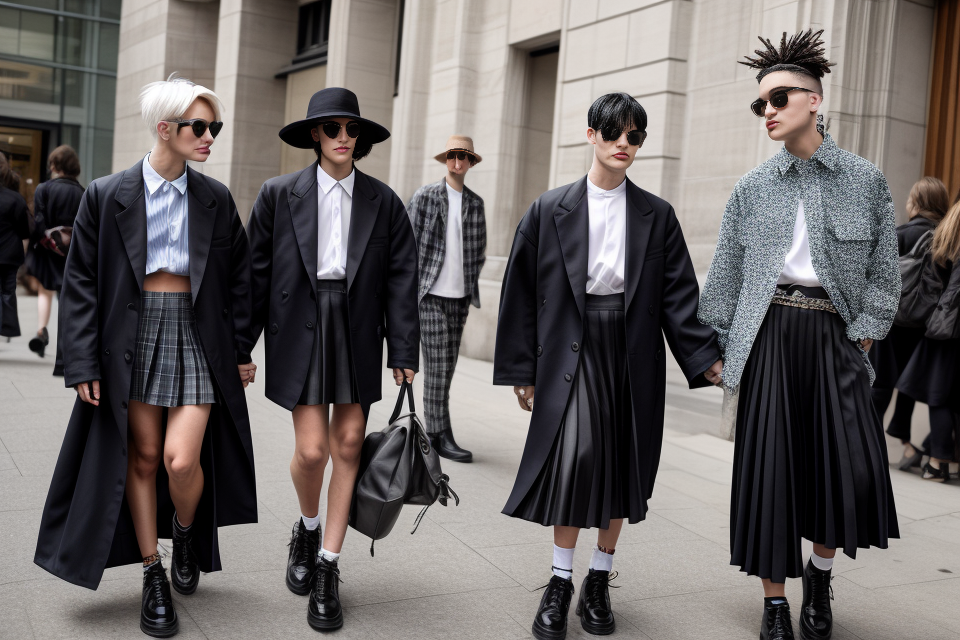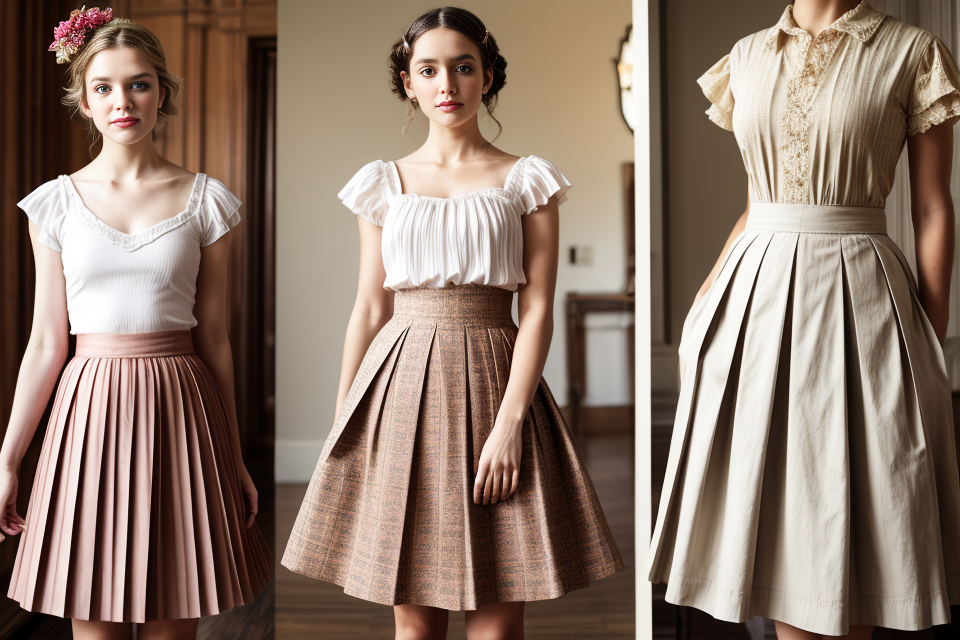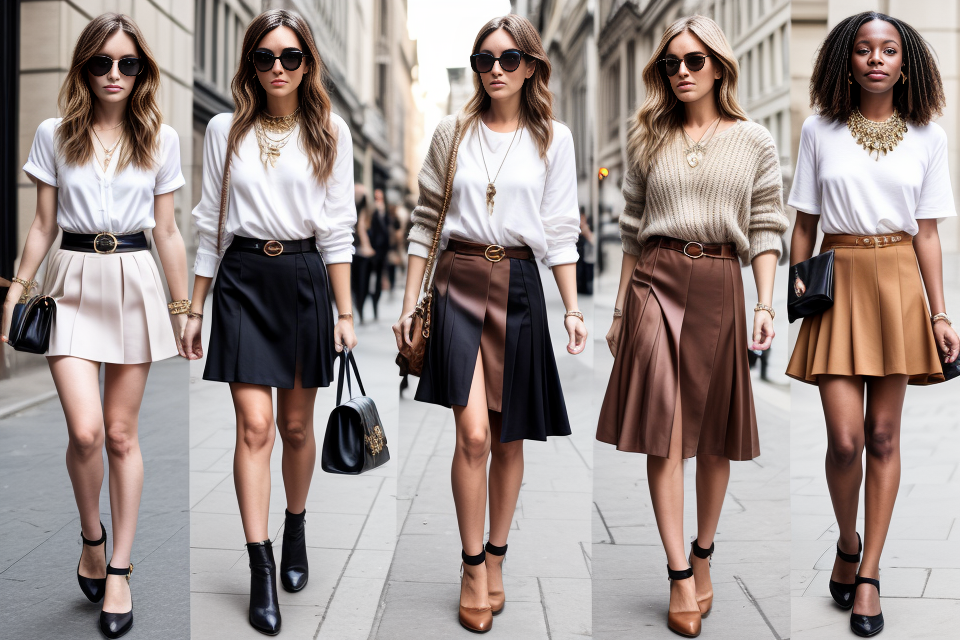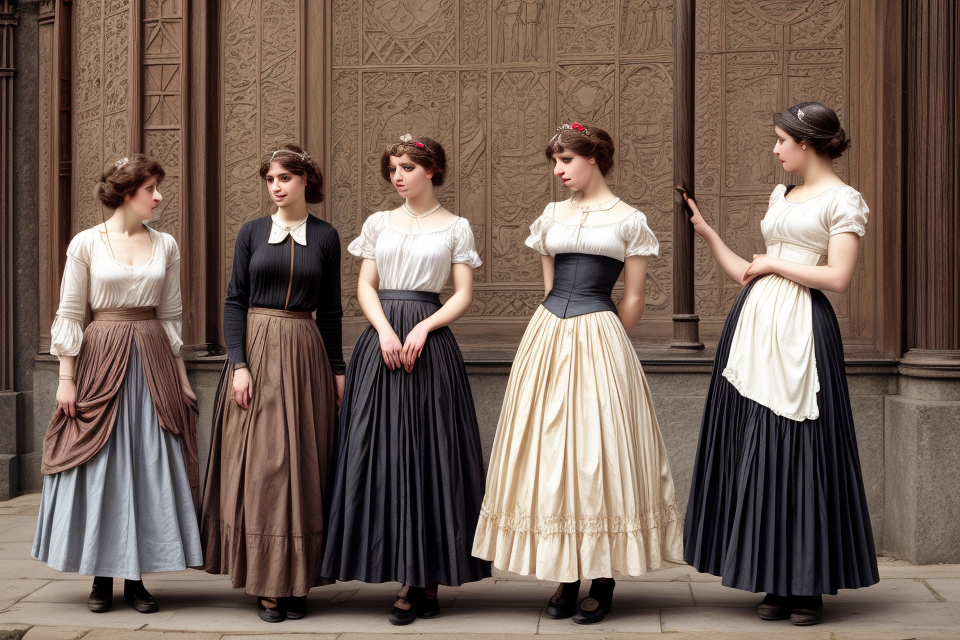Breaking fashion barriers, embracing gender-neutrality and challenging societal norms, more and more men are taking to wearing skirts as a fashion statement. But what is the name for this daring trend? Explore the world of gender-neutral fashion as we delve into the meaning behind this bold choice. Get ready to uncover the inspiration behind this daring trend and learn why it’s more than just a passing fad. Whether you’re a fan of this look or just curious, this article will provide an insightful perspective on the growing movement of men in skirts. So, let’s get started and find out what it’s called when a guy wears a skirt!
Understanding the gender-neutral fashion trend
The rise of gender-neutral clothing
The fashion industry has witnessed a significant shift towards gender-neutral clothing in recent years. This trend is driven by a growing number of individuals who reject traditional gender norms and expectations. As a result, the demand for clothing that transcends conventional gender boundaries has increased.
One of the primary reasons behind the rise of gender-neutral clothing is the growing awareness of the importance of inclusivity and diversity. Many designers and brands have embraced this trend, offering clothing that is not only fashionable but also comfortable and functional for people of all genders.
Moreover, the rise of social media platforms has played a crucial role in the popularization of gender-neutral fashion. Instagram, in particular, has become a hub for individuals to showcase their personal style and share their thoughts on gender-neutral clothing. This has helped to create a community of like-minded individuals who are passionate about challenging gender norms through fashion.
Another factor contributing to the rise of gender-neutral clothing is the increasing acceptance of non-binary identities. More and more people are identifying as non-binary, which means they do not identify as exclusively male or female. As a result, there is a growing demand for clothing that reflects this identity and allows individuals to express themselves authentically.
Furthermore, the rise of gender-neutral clothing has also been influenced by the broader cultural context of social and political movements. For instance, the #MeToo movement has encouraged individuals to challenge traditional gender roles and expectations, while the LGBTQ+ rights movement has helped to create a more accepting and inclusive society.
Overall, the rise of gender-neutral clothing is a reflection of a broader societal shift towards greater inclusivity and acceptance of diverse identities and expressions. As this trend continues to gain momentum, it is likely that we will see even more innovative and creative expressions of gender-neutral fashion in the years to come.
The importance of gender-neutral fashion
- Promoting inclusivity and diversity
- Encouraging individuals to express their gender identity through clothing
- Providing a space for those who do not identify as strictly male or female to feel represented in fashion
- Challenging traditional gender norms
- Breaking down societal expectations of what is considered appropriate attire for different genders
- Encouraging individuals to question and challenge gender stereotypes
- Fostering creativity and self-expression
- Allowing individuals to experiment with different styles and expressions of themselves
- Encouraging self-expression and individuality in fashion choices
- Opening up new opportunities for fashion design and retail
- Expanding the market for gender-neutral clothing and accessories
- Encouraging fashion designers and retailers to think outside the box and challenge traditional gender norms in their designs and offerings.
The history of men wearing skirts
The cultural significance of men wearing skirts in different societies
In various cultures throughout history, men have worn skirts as a symbol of masculinity, social status, or as a means of practicality. For instance, in ancient Rome, the toga was a long, flowing garment that men wore as a symbol of their citizenship and social status. Similarly, in ancient Greece, the himation was a draped garment worn by men as a sign of respectability and often as a symbol of their social standing.
In some societies, men wearing skirts was also a sign of spiritual or religious devotion. For example, in Tibet, monks wear a type of skirt called a “Kira” as a symbol of their vows of celibacy and commitment to a life of spiritual study. Similarly, in certain parts of Africa, men wear skirts as a symbol of their connection to traditional spiritual practices.
In other societies, men wearing skirts was simply a matter of practicality. For example, in the Scottish Highlands, men wore kilts as a way to keep warm and dry in the wet and cold climate. Similarly, in some parts of India, men wear a type of skirt called a “dhoti” as a way to stay cool in the hot climate.
Despite the cultural significance of men wearing skirts in different societies, the practice has often been met with resistance and criticism in modern times. Many people view the idea of men wearing skirts as a challenge to traditional gender norms and expectations, and some have criticized the trend as being overly feminine or unmanly. However, proponents of gender-neutral fashion argue that there is no inherent gender in clothing, and that people should be free to wear whatever makes them feel comfortable and expresses their individuality.
The modern resurgence of men wearing skirts
In recent years, there has been a noticeable shift in fashion trends, with a growing number of men embracing skirts as a fashion statement. This modern resurgence of men wearing skirts can be attributed to several factors, including the rise of gender-neutral fashion, the influence of social media, and the growing acceptance of alternative gender expressions.
One of the primary drivers of this trend is the growing awareness and acceptance of gender-neutral fashion. As more individuals reject traditional gender norms, they are seeking clothing options that do not conform to traditional gender roles. Skirts, which were once considered a distinctly feminine garment, are now being embraced by men as a way to express their individuality and challenge gender stereotypes.
Social media has also played a significant role in the modern resurgence of men wearing skirts. With the rise of platforms like Instagram and TikTok, individuals can share their fashion choices with a broader audience, making it easier for men to explore and embrace skirts as a fashion statement. Influential figures, such as celebrities and fashion icons, have also helped to popularize the trend by wearing skirts in public and on social media.
Additionally, the growing acceptance of alternative gender expressions has created a more inclusive environment for men who wish to wear skirts. As society becomes more aware of and accepting of non-binary and genderqueer individuals, men who choose to wear skirts are no longer met with the same level of disapproval or stigma. This has allowed for a greater range of fashion choices for all individuals, regardless of gender identity.
Overall, the modern resurgence of men wearing skirts is a reflection of the growing acceptance of gender-neutral fashion and the growing awareness and acceptance of alternative gender expressions. As more individuals embrace their individuality and challenge traditional gender norms, it is likely that this trend will continue to gain momentum in the coming years.
Types of skirts for men
Kilts and traditional skirts
When it comes to skirts for men, kilts and traditional skirts are two popular options. Kilts, which originated in Scotland, are a type of skirt that is typically made of wool and has a pleated design. They are often worn as part of traditional Scottish attire and are often seen at events such as weddings, festivals, and ceremonies.
Traditional skirts, on the other hand, are a more general term that can refer to any type of skirt that is traditionally worn by men in a particular culture or region. These skirts can come in a variety of styles and materials, and are often worn as part of a traditional costume or uniform.
While kilts and traditional skirts have been worn by men for centuries, they have recently become more popular as a fashion statement. Many men have started to incorporate these types of skirts into their everyday wardrobe, seeing them as a way to express their individuality and challenge traditional gender norms.
Modern skirts and dresses for men
As the fashion industry continues to evolve, more and more designers are exploring the idea of gender-neutral clothing. This means that clothing items that were traditionally associated with one gender are now being made available to people of all genders. One example of this is the modern skirt or dress for men.
Modern skirts and dresses for men come in a variety of styles and materials. Some are designed to be worn as part of a traditional suit, while others are more casual and can be worn on their own. Many of these skirts and dresses are made from materials that are typically associated with women’s clothing, such as silk and lace.
One of the benefits of modern skirts and dresses for men is that they offer a more comfortable alternative to traditional pants and shorts. They are often designed to be loose-fitting and comfortable, making them ideal for hot weather or for people who are on their feet for long periods of time.
Another benefit of modern skirts and dresses for men is that they can be worn in a variety of settings. They can be dressed up for formal events or worn casually for everyday wear. They can also be layered over other clothing items to create a unique and stylish look.
Overall, modern skirts and dresses for men are a great example of how the fashion industry is becoming more inclusive and diverse. By offering clothing options that were previously only available to people of one gender, designers are helping to break down barriers and create a more accepting and open-minded society.
Advantages of wearing skirts for men
- Comfort: One of the main advantages of wearing skirts for men is that they are often more comfortable than pants. Skirts are generally made of lightweight fabrics that allow for better airflow and can be more breathable than denim or other heavier materials.
- Versatility: Skirts can be worn in a variety of settings, from casual outings to formal events. They can be dressed up or down depending on the occasion, making them a versatile choice for men’s fashion.
- Expression: Wearing a skirt can be a form of self-expression for men who want to challenge traditional gender norms and express their individuality. Skirts come in a range of styles and colors, allowing men to choose a garment that reflects their personal taste and identity.
- Increased range of motion: Skirts often have a more flexible design than pants, which can allow for a greater range of motion. This can be especially beneficial for men who work in physically demanding jobs or engage in sports or other activities that require a high level of mobility.
- Better for hot weather: Skirts are often more suitable for hot weather than pants. They allow for better airflow around the legs, which can help keep men cool and comfortable in warmer temperatures.
Challenges of wearing skirts for men
While the concept of men wearing skirts is not new, it is still a relatively uncommon sight in many parts of the world. As a result, men who choose to wear skirts may face a number of challenges, both practical and social.
One of the practical challenges of wearing skirts for men is finding the right size and fit. Traditional women’s clothing is often designed to fit a specific body type, which can make it difficult for men to find skirts that fit well. Additionally, men may need to alter or customize their skirts to ensure a proper fit, which can be time-consuming and expensive.
Another challenge is the social stigma associated with men wearing skirts. In many cultures, skirts are seen as a feminine garment, and men who wear them may be subject to ridicule or discrimination. This can make it difficult for men to feel comfortable and confident when wearing skirts in public, especially if they are not used to the attention and scrutiny that may come with it.
Men who choose to wear skirts may also face challenges in terms of professionalism and career advancement. Some workplaces may have dress codes that prohibit men from wearing skirts, which can limit their job opportunities or make it difficult to advance in their careers. Additionally, some people may view men who wear skirts as less serious or less committed to their work, which can impact their professional reputation and success.
Overall, while the fashion industry has become more inclusive and diverse in recent years, men who choose to wear skirts may still face a number of challenges and obstacles. However, as more and more men embrace gender-neutral fashion, these challenges may begin to diminish, and skirts may become a more accepted and normalized part of men’s wardrobes.
The future of gender-neutral fashion
The impact of social media on gender-neutral fashion
- Social media has played a significant role in the rise of gender-neutral fashion.
- Platforms such as Instagram and TikTok have provided a space for individuals to showcase their unique styles and express their gender identity through fashion.
- This has led to an increase in the visibility of gender-neutral fashion and has encouraged more designers to create clothing that caters to a diverse range of gender identities.
- Social media has also created a community of individuals who support and promote gender-neutral fashion, further driving its popularity and acceptance.
- Influential figures on social media, such as celebrities and fashion bloggers, have also helped to normalize the trend by incorporating gender-neutral clothing into their personal styles.
- Social media has made it easier for individuals to access information about gender-neutral fashion and has created a platform for discussions about gender and fashion.
- The impact of social media on gender-neutral fashion is likely to continue to grow as more individuals turn to these platforms to express themselves and connect with others who share their interests.
The influence of celebrities and influencers
Celebrities and influencers have played a significant role in shaping fashion trends and norms. With the rise of gender-neutral fashion, these individuals have taken the lead in promoting and normalizing the wearing of skirts and other traditionally gendered clothing by men.
Some of the most notable figures who have embraced this trend include Harry Styles, who famously donned a dress on the cover of AnOther Man magazine, and Billy Porter, who has become known for his bold and gender-fluid red carpet looks. Other celebrities such as Jaden Smith, Janelle Monae, and Ruby Rose have also been seen wearing skirts and other traditionally feminine clothing, further contributing to the normalization of this trend.
In addition to celebrities, social media influencers have also played a significant role in promoting gender-neutral fashion. Many influencers have taken to social media platforms such as Instagram and TikTok to showcase their own gender-neutral looks and to encourage their followers to do the same. This has helped to create a sense of community and acceptance around the trend, as well as to broaden the conversation around gender and fashion.
Overall, the influence of celebrities and influencers has been instrumental in promoting the acceptance and normalization of gender-neutral fashion. As more and more individuals continue to embrace this trend, it is likely that we will see even greater progress towards a more inclusive and diverse fashion industry.
The growing acceptance of gender-neutral fashion in mainstream society
The concept of gender-neutral fashion has been gaining traction in recent years, as more and more individuals seek to express their unique style and identity beyond traditional gender norms. This growing acceptance of gender-neutral fashion in mainstream society can be observed in a number of ways, from the increasing visibility of gender-neutral clothing in mainstream retail stores to the emergence of prominent figures in media and entertainment who are embracing gender-neutral fashion.
One of the most notable aspects of the growing acceptance of gender–neutral fashion in mainstream society is the expanding range of clothing options available to individuals who do not identify as strictly male or female. Many retailers are now offering clothing lines that are designed to be gender-neutral, with features such as adjustable waists and hemlines that can be tailored to fit a variety of body types and gender expressions. This has opened up new possibilities for individuals who may have previously felt constrained by traditional gender norms in their clothing choices.
Another important factor in the growing acceptance of gender-neutral fashion is the emergence of prominent figures in media and entertainment who are embracing this trend. From celebrities to influencers, there is a growing number of individuals who are using their platforms to promote gender-neutral fashion and challenge traditional gender norms. This has helped to bring greater visibility to the gender-neutral fashion movement and has encouraged more individuals to feel comfortable exploring their own unique style and identity.
Additionally, the growing acceptance of gender–neutral fashion in mainstream society has also been fueled by the rise of social media and online communities that are dedicated to promoting and celebrating gender-neutral fashion. These communities provide a space for individuals to share their own experiences and connect with others who are interested in exploring gender-neutral fashion. This has helped to create a sense of community and support around this trend, which has further contributed to its growing acceptance in mainstream society.
Overall, the growing acceptance of gender–neutral fashion in mainstream society represents a significant shift in the way that individuals are approaching their clothing choices and expressing their identity. As more and more individuals embrace this trend, it is likely that we will continue to see a wider range of clothing options and greater visibility for gender-neutral fashion in the years to come.
FAQs
1. What is it called when a guy wears a skirt?
Answer: The term used to describe a man wearing a skirt is “skirt-wearing man” or simply “man in a skirt.” Some people also use the term “skirt-wearing male” or “male wearing a skirt.”
2. Is wearing a skirt a new trend for men?
Answer: Wearing skirts has been a part of some cultures for centuries, but it has not been a common practice in Western fashion until recently. In recent years, there has been a growing trend of men wearing skirts as a form of gender-neutral fashion. This trend has gained popularity on social media and has been featured in fashion shows and magazines.
3. Why are men wearing skirts?
Answer: Men are wearing skirts for various reasons. Some do it as a form of gender expression and to challenge traditional gender norms. Others wear skirts as a fashion statement or as a way to express their personal style. Some men also wear skirts for practical reasons, such as for sports or for cultural events.
4. Is wearing a skirt considered masculine or feminine?
Answer: Wearing a skirt is not inherently masculine or feminine. Traditionally, skirts have been associated with femininity, but in recent years, the trend of men wearing skirts has challenged this association. Some people view skirts as a gender-neutral garment that can be worn by anyone, regardless of gender.
5. Are there any specific types of skirts that men commonly wear?
Answer: There are many types of skirts that men can wear, including A-line skirts, mini skirts, maxi skirts, and skater skirts. Some men also wear kilts, which are a traditional Scottish garment consisting of a long skirt with pleats.
6. How do people react to men wearing skirts?
Answer: People’s reactions to men wearing skirts can vary widely. Some people may be supportive and appreciate the trend of gender-neutral fashion, while others may be more conservative and view skirts as a garment for women only. In some cases, men who wear skirts may face discrimination or harassment.
7. Are there any cultural or religious considerations for men wearing skirts?
Answer: Yes, there are some cultural and religious considerations to take into account when it comes to men wearing skirts. In some cultures, such as Scottish culture, men traditionally wear skirts as part of their national dress. In other cultures, such as Islamic culture, men may wear skirts or garments similar to skirts as a form of modesty. It is important to be respectful of cultural and religious traditions when considering whether or not to wear a skirt.



